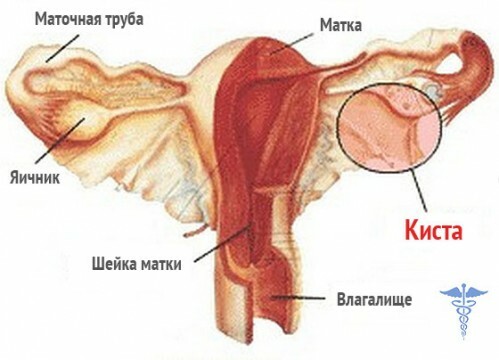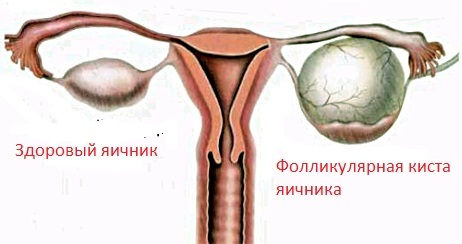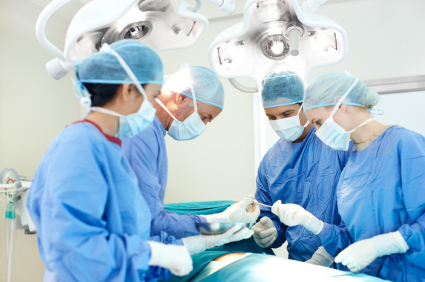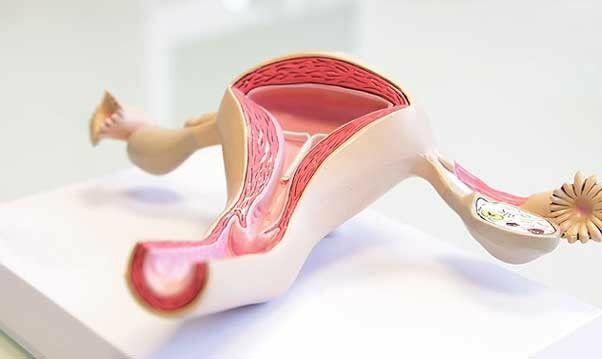The follicular cyst is a neoplasm that can cause many problems to women. This formation has different sizes( from 2 to 10 cm) and is characterized by a number of features. Basically, the tumor has a single chamber cavity where fluid accumulation takes place. In most cases, this kind of pathology can appear in young women. A little less often the symptoms of such a disease are diagnosed at a later age.
The follicular cyst is able to appear and dissolve when certain conditions are created spontaneously. At the same time, this type of tumor is not able to go into malignant education, but it needs to be treated in a timely manner.
Causes of the appearance of the

cyst. Often a cyst may appear after inflammatory processes occurring in the ovaries and uterus, as well as after them.
An example of such pathologies are:
- oophoritis;
- adnexitis;
- salpingitis.
In some situations, symptoms appear after abortion or poor recovery after surgery.
Frequent occurrences of pathology
Pathologies may appear in the following cases:
- with hormonal imbalance;
- uncontrolled use of drugs based on hormones. This applies to the use of contraceptives;
- after delivery;
- for thyroid disorders;
- after infertility treatment;
- after a serious stressful situation.
Sometimes it happens that the cyst occurs in newborns, but in most cases it disappears for several weeks and it does not have to be treated.
In the case when a woman leads a healthy way of life and does not burden the body with hormonal drugs, the risk of the disease is low, but it does exist.
The emergence of the follicular cyst

In the normal functioning of the female reproductive system, during the menstrual cycle, follicles are produced. The more active ones are the base for the maturation of eggs. When the egg is released, they move along the tubes towards the uterus.
In places where there is a rupture of the follicle, the body remains of lutein. It plays the role of a temporary endocrine gland. This formation contributes to the production of a substance such as progesterone. During this period, conception may occur.
In a situation where the follicle does not burst, the egg does not come out. It remains inside the same follicle. In the cavity a certain amount of follicular fluid accumulates, or rather its excess. This is the reason for the formation of the cyst.
This formation is increased due to serum infiltration through the vessels into the cavity of the cyst itself. This is also facilitated not by the cessation of the secretion of epithelial cells.
Symptoms of the follicular cyst
Symptoms of such a disease strongly depend on the activity of the hormonal system. And also from the presence of concomitant diseases in the pelvic area. Such diseases include:
- endometriosis;
- fibroid;
- adnexitis and others.
In a situation where the cyst is not active, it can develop without any symptoms. This does not exclude the resorption of education without any intervention. In this case, there is no reason to worry.
In a situation where the cyst is active and rapidly produces estrogen, its manifestation occurs in the form of severe bleeding during the menstrual cycle, especially in the early age of girls. This is accompanied by severe pain in the lower abdomen.

The follicular cyst is incapable of manifesting, it can be detected quite accidentally, for example, during clinical examination.
If the dimensions of the formation are large, the symptoms of the follicular cyst may be as follows:
- pain after walking or running;
- marked decrease in body temperature, especially at the end of the menstrual cycle( indicators can reach 35.7-36 °);
- discomfort in the lower abdomen;
- permanent gravity in the groin area, at the location of the approximate cyst;
- pain during intercourse;
- pain before the menstrual cycle;
- uterine bleeding.
Causes of complications after
disease The follicular cyst is not very dangerous, but the consequences it entails are more unpleasant. These include ruptures of the cyst or the torsion of the legs.
Symptoms during the onset of the rupture:
- , the temperature of the affected woman remains constant;
- fainting;
- vomiting;
- sharp pain in the place of localization of pathology.
Symptoms when twisting the legs:
- cold sweat;
- persistent weakness and dizziness;
- severe nausea;
- pain in the lower abdomen;
- reduced pressure;
- is a cyanotic complexion of the face.
Methods for treating the follicular ovarian cyst

If the cyst has a diameter of less than 5 cm, it almost does not bother and is able to pass by itself. But, if with the help of a gynecological ultrasound the cyst is found, experts advise not to hurry, because it can pass independently. More effective in this situation is the method of waiting.
Waiting method
It is necessary to wait a little - all of a sudden it will pass. H, if the next visit to a specialist on the passage of a month or two cyst is not decreased, a treatment is prescribed.
Treatment of follicular ovarian cyst with medicines
When women with childbearing relapse of a pathology or a rapid increase in the size of the ovaries show up, medications that are able to normalize the background of hormones will help. Sometimes simple contraceptive pills are used for this. To treat a cyst in accordance with its size and activity can be with the use of special vitamins and anti-inflammatory drugs.
Treatment with physiotherapy
Physiotherapeutic procedures are used to accelerate the resolution of pathological formation:
- electrophoresis;
- magnetotherapy;
- phonophoresis.
All procedures are prescribed by a doctor. It is worth noting that when the size of the cyst is more than 5 cm, then such procedures are ineffective. In this case, you need to treat using surgical intervention.
Removal of ovarian cyst with laparoscopy
This operation is planned. After laparoscopy, there are no traces left in the patient. In most cases epidural anesthesia is used instead of anesthesia.
Surgical intervention

When a serious danger, for example, rapid growth of the tumor or the appearance of the probability of rupture, surgical intervention is applied. In this case, there are several options:
- Ovariectomy - in this case there is a complete removal of the damaged ovary.
- Kystectomy - only neoplasms are removed. After passing a certain amount of time, the ovaries can fully recover.
- Tumor resection - together with the cyst, the damaged tissue of the ovary is removed. In this case, the childbearing functions are preserved.
Prevention
The cause of the onset of the disease depends largely on the conduct of a lifestyle and health status in general. To prevent the appearance of pathology, you need:
- to lead a healthy way of life
- healthy sleep;
- needs to control body weight;
- to avoid abortion;
- to control menstrual cycles;
- visit the gynecologist regularly.
Finding such a pathology in women should make them think about their own health and without hesitation, turn to a specialist.



